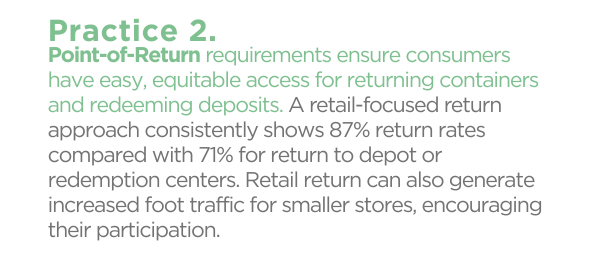Hello there!
Welcome to the 12th issue of Bottle Bill Common Ground — a limited-series newsletter from Reloop North America highlighting evidence-based guidance for legislators, policy makers, industry, and advocates working on bottle bills. (If you haven’t read our first 11 issues, you can do so here.)
We are now focused on 10 essential practices — requirements on how to build, run, and maintain a modern deposit return system (DRS) for beverage containers. The second essential practice is:
The first of these essential practices for bottle bill legislation is:

Returning empty beverage containers for a deposit refund should be as easy as a routine grocery shopping trip. Point-of-return requirements in bottle bill legislation ensure a consumer-friendly collection network, which also drives up return rates for containers.
What factors contribute to easier access and an improved customer experience? First and foremost, a strong network of redemption points that:
- Are sufficient in number in a set of geographic areas
- Deliver a consistent, easy, clean, and safe customer experience
- Are as easy to access as going shopping
- Cater to both low- and high-volume redeemers
- Guarantee cash refunds, alongside other options (e.g., EFTs, vouchers)
- Are technology-led.
To be truly accessible, a DRS must also prioritize ease of access and usability for those living in rural areas, individuals who don’t own automobiles or modern mobile phones, persons with disabilities, low-income individuals, and historically marginalized communities that have faced access barriers and/or have endured previous institutional discrimination in program and service delivery.
In the Reimagining the Bottle Bill impact study, Reloop found that to achieve system accessibility and equity in Northeast DRS states, the distance to a redemption point should not exceed:
- Five miles in low population density rural areas
- Two miles in high density urban and suburban areas
- A half-mile in ultra-dense New York City.
Highly accessible systems consistently recover and recycle the highest amounts of material.

International experience also shows that return-to-retail (R2R) systems — where retailers selling beverages become legally responsible for accepting empty containers for recycling — generate the highest return rates. According to Reloop analysis, R2R models consistently show higher median return rates (87%) than return-to-depot or hybrid redemption models (71%).
R2R systems allow consumers to return their containers when they do their shopping or, if they are consuming their beverage outside of the home, to the nearest convenient location, which may be a shop or other local hub. These systems require no extra trips or additional travel time to return containers, which removes the barrier of “going out of your way” to recycle.
Case Study: Germany
In Germany, retailers are required to take back empty containers, but only those of the type that they sell. For example, a retailer that only sells PET bottles must accept all PET bottles regardless of their size or brand but is not obliged to take back aluminum or glass containers. Small retailers (with a floor area less than 2,150 square feet) only need to take back empty containers of the beverages they sell, with no limit. There are approximately 130,000 redemption locations in Germany, yielding a ratio of one return point for every 640 residents. Germany’s return rate in 2021 was 98%, the highest in Europe.
Thanks for reading! We encourage you to share this newsletter widely with those who want or need to know about these principles and practices. Working together from a common ground of knowledge, we can move good bottle bills forward. Sign up here to get these blog posts as emails.
